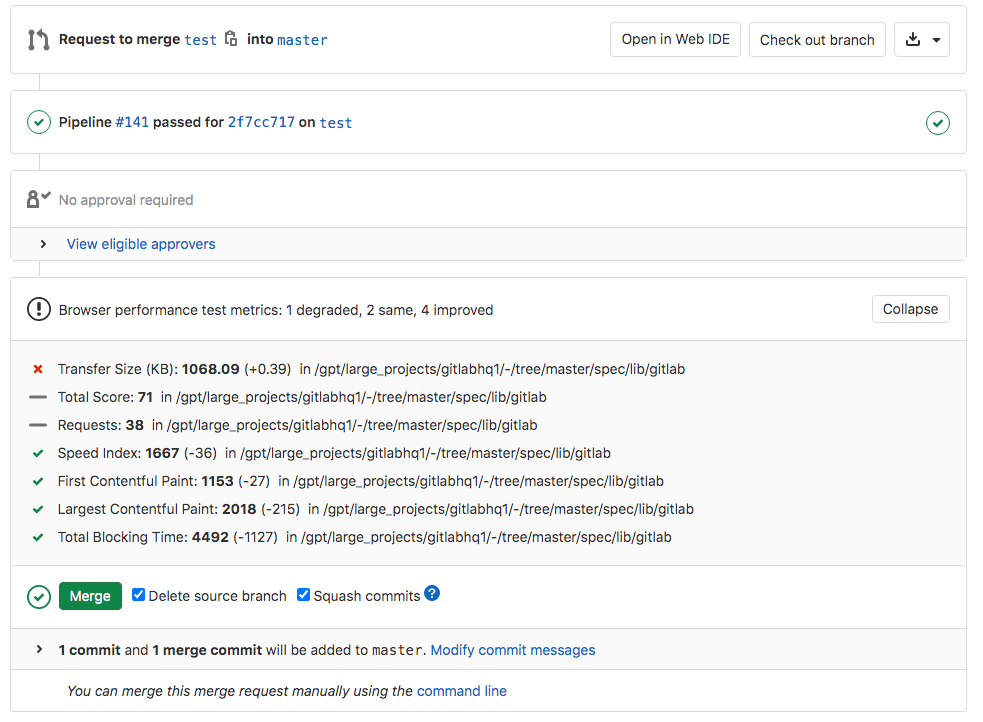Browser Performance Testing
DETAILS: Tier: Premium, Ultimate Offering: GitLab.com, GitLab Self-Managed, GitLab Dedicated
If your application offers a web interface and you're using GitLab CI/CD, you can quickly determine the rendering performance impact of pending code changes in the browser.
NOTE: You can automate this feature in your applications by using Auto DevOps.
Overview
GitLab uses Sitespeed.io, a free and open source
tool, for measuring the rendering performance of web sites. The
Sitespeed plugin that GitLab built outputs
the performance score for each page analyzed in a file called browser-performance.json
this data can be shown on merge requests.
Use cases
Consider the following workflow:
- A member of the marketing team is attempting to track engagement by adding a new tool.
- With browser performance metrics, they see how their changes are impacting the usability of the page for end users.
- The metrics show that after their changes, the performance score of the page has gone down.
- When looking at the detailed report, they see the new JavaScript library was
included in
<head>, which affects loading page speed. - They ask for help from a front end developer, who sets the library to load asynchronously.
- The frontend developer approves the merge request, and authorizes its deployment to production.
How browser performance testing works
First, define a job in your .gitlab-ci.yml file that generates the
Browser Performance report artifact.
GitLab then checks this report, compares key performance metrics for each page
between the source and target branches, and shows the information in the merge request.
For an example Browser Performance job, see Configuring Browser Performance Testing.
NOTE:
If the Browser Performance report has no data to compare, such as when you add the
Browser Performance job in your .gitlab-ci.yml for the very first time,
the Browser Performance report widget doesn't display. It must have run at least
once on the target branch (main, for example), before it displays in a
merge request targeting that branch. Additionally, the widget only displays if the
job ran in the latest pipeline for the Merge request.
Configuring Browser Performance Testing
- Support for the
SITESPEED_DOCKER_OPTIONSvariable introduced in GitLab 16.6.
This example shows how to run the sitespeed.io container on your code by using GitLab CI/CD and sitespeed.io using Docker-in-Docker.
-
First, set up GitLab Runner with a Docker-in-Docker build.
-
Configure the default Browser Performance Testing CI/CD job as follows in your
.gitlab-ci.ymlfile:include: template: Verify/Browser-Performance.gitlab-ci.yml browser_performance: variables: URL: https://example.com
The above example:
- Creates a
browser_performancejob in your CI/CD pipeline and runs sitespeed.io against the webpage you defined inURLto gather key metrics. - Uses a template that doesn't work with Kubernetes clusters. If you are using a Kubernetes cluster,
use
template: Jobs/Browser-Performance-Testing.gitlab-ci.ymlinstead.
The template uses the GitLab plugin for sitespeed.io, and it saves the full HTML sitespeed.io report as a Browser Performance report artifact that you can later download and analyze. This implementation always takes the latest Browser Performance artifact available. If GitLab Pages is enabled, you can view the report directly in your browser.
You can also customize the jobs with CI/CD variables:
-
SITESPEED_IMAGE: Configure the Docker image to use for the job (defaultsitespeedio/sitespeed.io), but not the image version. -
SITESPEED_VERSION: Configure the version of the Docker image to use for the job (default14.1.0). -
SITESPEED_OPTIONS: Configure any additional sitespeed.io options as required (defaultnil). Refer to the sitespeed.io documentation for more details. -
SITESPEED_DOCKER_OPTIONS: Configure any additional Docker options (defaultnil). Refer to the Docker options documentation for more details.
For example, you can override the number of runs sitespeed.io makes on the given URL, and change the version:
include:
template: Verify/Browser-Performance.gitlab-ci.yml
browser_performance:
variables:
URL: https://www.sitespeed.io/
SITESPEED_VERSION: 13.2.0
SITESPEED_OPTIONS: -n 5Configuring degradation threshold
You can configure the sensitivity of degradation alerts to avoid getting alerts for minor drops in metrics.
This is done by setting the DEGRADATION_THRESHOLD CI/CD variable. In the example below, the alert only shows up
if the Total Score metric degrades by 5 points or more:
include:
template: Verify/Browser-Performance.gitlab-ci.yml
browser_performance:
variables:
URL: https://example.com
DEGRADATION_THRESHOLD: 5The Total Score metric is based on sitespeed.io's coach performance score. There is more information in the coach documentation.
Performance testing on review apps
The above CI YAML configuration is great for testing against static environments, and it can be extended for dynamic environments, but a few extra steps are required:
- The
browser_performancejob should run after the dynamic environment has started. - In the
reviewjob:- Generate a URL list file with the dynamic URL.
- Save the file as an artifact, for example with
echo $CI_ENVIRONMENT_URL > environment_url.txtin your job'sscript. - Pass the list as the URL environment variable (which can be a URL or a file containing URLs)
to the
browser_performancejob.
- You can now run the sitespeed.io container against the desired hostname and paths.
Your .gitlab-ci.yml file would look like:
stages:
- deploy
- performance
include:
template: Verify/Browser-Performance.gitlab-ci.yml
review:
stage: deploy
environment:
name: review/$CI_COMMIT_REF_SLUG
url: http://$CI_COMMIT_REF_SLUG.$APPS_DOMAIN
script:
- run_deploy_script
- echo $CI_ENVIRONMENT_URL > environment_url.txt
artifacts:
paths:
- environment_url.txt
rules:
- if: $CI_COMMIT_BRANCH == $CI_DEFAULT_BRANCH
when: never
- if: $CI_COMMIT_BRANCH
browser_performance:
dependencies:
- review
variables:
URL: environment_url.txt